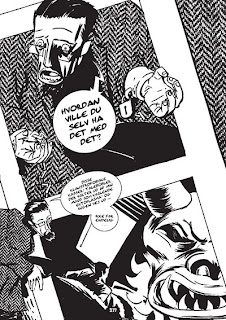I was obsessed with comicbooks when I was a schoolboy, American comicbooks. During some lessons I sat daydreaming, especially when the lesson involved the teacher talking about her time in Dar es Salaam - which she did a lot. I tried to imagine what comicbooks they had there, and then I was off, staring over at the globe in the corner of the room and imagining what comicboks were like in India, in Holland, in Italy, in Denmark.
It's still a real treat for me to get my grubby little mitts on these treasures, and I love seeing them in their native language, rather than in English translation. That's why I was delighted when Allan Haverholm let me have a copy of his graphic novel,
Sort-Mund, and had no problems with the fact that I cannot understand a word of Danish. I spoke with Allan about blogging on
Sort-Mund, and making a stab at what is going on in it, using only the drawings to feel my way through the story, and he decided it would be an interesting experiment. Besides, I figured that even if I was way off target with the story, I would still be able to share Allan's wonderful drawings with you.
A good place to start when you're reading a book is the title. A lot of thought goes into titles. Somewhere in the house here I have a copy of the sheet of paper Dickens used when he was struggling to name
Hard Times; he went through a lot of ideas before settling on that title. But I wanted to avoid looking at Babelfish and decided that Sort-Mund was a place. It's not, I now know,
Sort-Mund means Black Mouth, but I've avoided trying to translate chunks of dialogue because whether I've understood the text or not, I've been able to fashion some sort of story, in my head,
from Allan's drawings.
I love the opening page, our entry into the story, i's a stark, noirish, Dr Caligari-type cityscape, with Triffid-like tentacles breaking through the surface and blocking the path of a loan figure. He turns and races back the way, through a park, and then it becomes clear that the protagonist has been dreaming. The scene then switches to a domestic setting, but there are one or two visual clues that this sunny morning may retain something of the strangeness of last night's dream. The shadow of the window frame on his face forms the shape of the cross, outside his charming cottage, there's a black crow watching him collect his mail, the whistling kettle, the first real sound we hear screams across the page. We're pretty confident something is going to happen and there's a hint or two that it might involve religion of some sort, death, and maybe even something Lovecraftian.


The letter causing our protagonist, Manne Svarts, to go collect something from a counter or teller or collection point 665 (almost 666 and just one of the numerical and symbolic hints and clues laced through the text), and there may again be an interruption from a dream or from an imagined war-time scene. This worrying thread, that suggests a fracture of some sort in our hero's thinking or even in his mind, continues as we move from the protagonist's reality of modern-day Denmark, of coffee houses and bus trips, back into his violent dream scape where he dreams within the dream and morphs into the violent perpetrator. It's becoming clear that reality and fantasy are becoming problematic for our hero.


There are really nice shifts in POV as Allan introduces different characters, like the trendy young researchers, into the story, and the noir mood lights even the most cozy, domestic, scenes, warning us that there is a dark shadow hovering over the text. That dark shadow belongs to Satan, and the introduction of a diabolical book is very well handled by the artist, with a nice change of lettering to establish the text of the book as separate from the text of the story itself and the angular drawing establish the book's illustrations as different from the reality-based illustrations of the story. The pace moves on and the story carries us into some exciting visual areas as a modern computer-driven reality, and a dream scape melded to chessboard, swirl around the pages and remind us of the famous scene in that old movie where the Gods summon the Titans and play chess with human lives.



It soon becomes clear that the violent dreams have some basis in reality, and that people in Copenhagen are being killed. And our protagonist's vivid nightmares, his day dreams, and the voices he is hearing in his head, have to lead us to wonder if he maybe isn't actually polishing people off himself. But he is just one of the suspects in this tale that jumps time zones and hints at macabre doings and arcane knowledge, and I'm now suddenly conscious that I might accidentally stumble onto the truth of the story and produce spoilers, so I'm going to stop now.
I think Allan has produced a pretty impressive graphic novel with
Sort-Mund, and I wish I'd got it years ago when it was first published. The sheer amount of experimentation with lighting, with the lettering, with the panel structure, puts me in mind of the sort of experiments that Joyce dabbled with in Ulysses. In many ways, Allan has made some very bold decisions in Sort Mund, and it's a book that should be studied by other graphic novelists because it has some pretty fancy pen work and some great ideas.

















































